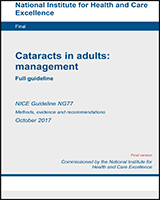NCBI Bookshelf. A service of the National Library of Medicine, National Institutes of Health.
Excerpt
A cataract is defined as any opacity in the crystalline lens of the eye. It can affect one or both eyes. The changes to the transparency and refractive index of the lens result in various levels of visual impairment. This impairment is associated with decreased quality of life because it may restrict the person’s ability to carry out daily activities and function independently, while increasing the risk of accidents and falls.
Cataracts most commonly affect adults as a result of biological ageing (age-related cataracts) and may be classified according to the area of the lens that is affected (nuclear sclerotic, cortical or posterior subcapsular cataracts). Cataracts can also occur in children, and may be classified according to the age of onset (congenital or infantile/juvenile cataracts). This guideline only covers cataracts in people who are 18 years or older. Cataracts may occur secondary to hereditary factors, trauma, inflammation, metabolic or nutritional disorders, and exposure to radiation. In addition, lifestyle factors such as tobacco smoking and high alcohol intake are associated with an increased risk of developing age-related cataracts. Most cataracts are progressive, although the decline in visual function may be variable and unpredictable. The natural history of cataracts depends on the type and severity of the cataract and the presence of comorbid ocular conditions. In severe, untreated cases, cataracts can lead to significant reduction in vision, which is reversible with cataract surgery, although some level of visual impairment may persist.
This guideline covers managing cataracts in adults aged 18 and over. It aims to improve care before, during and after cataract surgery by optimising service organisation, referral and surgical management, and reducing complications. It further aims to improve the availability of information for people with cataracts before, during and after cataract surgery.
Contents
- Summary
- 1. Guideline committee membership and ICG technical team
- 2. Strength of recommendation
- 3. Methods
- 3.1. Evidence synthesis and meta-analyses
- 3.2. Evidence of effectiveness of interventions
- 3.3. Methods for combining direct and indirect evidence (network meta-analysis) for interventions
- 3.4. Association studies
- 3.5. Non-comparative studies
- 3.6. Qualitative evidence
- 3.7. Mixed-quantitative and qualitative evidence
- 3.8. Health economics
- 3.9. External collaborations
- 4. Summary of recommendations
- 5. Patient information
- 6. Indicators for referral
- 7. Preoperative assessment and biometry
- 8. Intraocular lens selection
- 9. Wrong lens implant errors
- 10. Surgical timing and technique
- 11. Anaesthesia
- 12. Preventing and managing complications
- 12.1. Interventions to prevent retinal detachment in people with myopia
- 12.2. Intraoperative pupil size management
- 12.3. Interventions to reduce the impact of perioperative posterior capsule rupture
- 12.4. Capsular tension rings
- 12.5. Interventions to prevent endophthalmitis
- 12.6. Interventions to prevent cystoid macular oedema
- 12.7. Managing cystoid macular oedema
- 12.8. Postoperative eye shields
- 13. Postoperative assessment
- 14. Glossary
- Appendix A. Committee membership list – Cataracts in adults: management Guideline Committee
- Appendix B. Guideline scope
- Appendix C. Review Protocols
- Appendix D. Review search strategies
- Appendix E. Evidence tables
- Appendix F. Excluded studies
- Appendix G. GRADE and CERQual Tables
- Appendix H. Meta-analysis and Network meta-analysis Results
- Appendix I. References
- Appendix J. Health economics
- Appendix K. Evidence review flow charts
- Appendix L. Research recommendations
Final
Commissioned by the National Institute for Health and Care Excellence
Disclaimer: Healthcare professionals are expected to take NICE clinical guidelines fully into account when exercising their clinical judgement. However, the guidance does not override the responsibility of healthcare professionals to make decisions appropriate to the circumstances of each patient, in consultation with the patient and/or their guardian or carer.
- NLM CatalogRelated NLM Catalog Entries
- Relation of ocular trauma to cortical, nuclear, and posterior subcapsular cataracts: the Beaver Dam Eye Study.[Br J Ophthalmol. 2002]Relation of ocular trauma to cortical, nuclear, and posterior subcapsular cataracts: the Beaver Dam Eye Study.Wong TY, Klein BE, Klein R, Tomany SC. Br J Ophthalmol. 2002 Feb; 86(2):152-5.
- Review Eye Conditions in Older Adults: Cataracts.[FP Essent. 2016]Review Eye Conditions in Older Adults: Cataracts.Iroku-Malize T, Kirsch S. FP Essent. 2016 Jun; 445:17-23.
- Phakic intraocular lenses for the treatment of refractive errors: an evidence-based analysis.[Ont Health Technol Assess Ser....]Phakic intraocular lenses for the treatment of refractive errors: an evidence-based analysis.Medical Advisory Secretariat. Ont Health Technol Assess Ser. 2009; 9(14):1-120. Epub 2009 Oct 1.
- Review Lipid peroxidation and cataracts: N-acetylcarnosine as a therapeutic tool to manage age-related cataracts in human and in canine eyes.[Drugs R D. 2004]Review Lipid peroxidation and cataracts: N-acetylcarnosine as a therapeutic tool to manage age-related cataracts in human and in canine eyes.Babizhayev MA, Deyev AI, Yermakova VN, Brikman IV, Bours J. Drugs R D. 2004; 5(3):125-39.
- The impact of cataract, cataract types, and cataract grades on vision-specific functioning using Rasch analysis.[Am J Ophthalmol. 2012]The impact of cataract, cataract types, and cataract grades on vision-specific functioning using Rasch analysis.Chew M, Chiang PP, Zheng Y, Lavanya R, Wu R, Saw SM, Wong TY, Lamoureux EL. Am J Ophthalmol. 2012 Jul; 154(1):29-38.e2. Epub 2012 Apr 26.
- Cataracts in adults: managementCataracts in adults: management
Your browsing activity is empty.
Activity recording is turned off.
See more...
